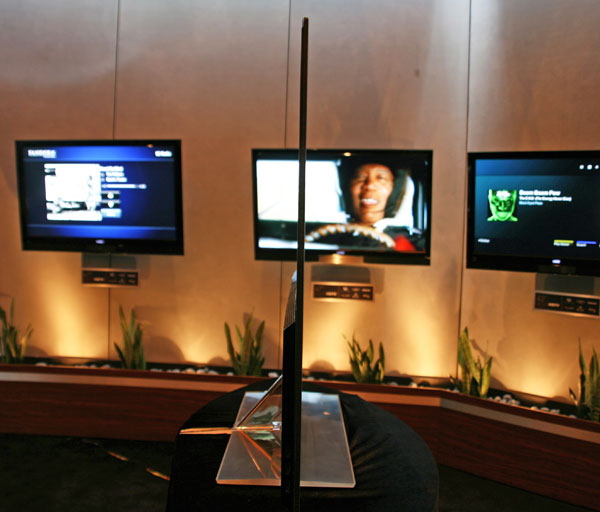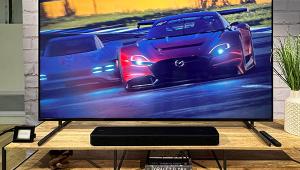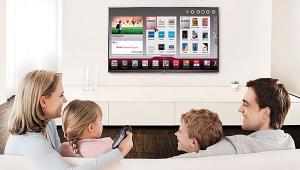Should You Get an LCD or Plasma Flat Panel? Page 2

If you tend to play games and/or watch sports or other fast-motion material and you decide on an LCD, get one that refreshes the screen 120 or 240 times per second (120Hz or 240Hz) instead of the conventional 60Hz, which suffers from "motion blur." When this higher refresh rate is combined with frame interpolationnew frames are generated by the TV to fill in the gaps between actual frames, as shown abovethey can significantly sharpen onscreen motion. (Frame interpolation is also called motion estimation/motion compensation, or MEMC.) On the downside, it can also introduce an artifact called the "soap-opera effect," which makes movies look like they were shot on video. Many people hate the way this looks, but I can easily tolerate it in favor of less motion blur.

Just to be perfectly clear, LED backlighting with local dimming, which is used in the SIM2 HDR47 seen here, and high refresh rates with frame interpolation are designed to address problems that plasmas do not suffer from in the first place. On the other hand, LCD TVs exhibit much less image retention than plasmas.
In what environment will I be watching?
If you have good control of ambient light in the room, or you watch mostly at night and can dim or turn off the room lights, either type of flat panel will work just fine, and as I said earlier, I prefer the look of plasma in this case. However, if you watch during the day without good black-out shades or you need to leave the lights on, LCD is often the better choice.
Plasmas have a shiny, reflective screen, while many LCDs have a matte screen that does not reflect room light nearly as much. (Samsung LCDs are one exception with shiny screens.) So if you watch the TV with lots of room light, you can often see yourself and other objects reflected in a plasma screen, especially during dark scenes. This problem is even worse during the day if there's a window or glass door directly opposite the screen.
Will it normally be a large or small group watching?
If you often host a large gathering around the electronic hearth, or you often watch from off-centersay, from the kitchen while cookingplasma is a better bet with its much wider viewing angle. If you mostly fly solo or cozy up to your partner for an evening's video entertainment directly in front of the TV, either technology will work fine.

In the graphic above, the upper two images show a plasma directly on axis and about 45 degrees off axis; the lower two images show the same views with an LCD TV. Notice that the colors tend to wash out more on the LCD when viewed off axis, and the difference between white and black in the bottom row of squares is diminished, leading to less contrast in the picture.
How much can I afford to spend?
Inch for inch, LCDs have traditionally been more expensive than plasmas, and this is often still trueat least slightlyfor screen sizes of 50 inches or more. And LED-backlit LCDs are definitely more expensive than similarly sized plasmas and LED-edgelit LCDs. Of course, features also play an important role: 3D capabilities, online apps, more inputs, even cabinetry all affect the price of both types of displays.

Speaking of cabinetry, all types of flat panels are getting mighty skinny these days; thinnest of all are LED-edgelit LCDs, such as the Vizio Blade seen edge-on in the photo above. If you intend to mount your new flat panel on the wall, pay attention to the cable connectionssuper-thin panels often have connections oriented sideways, which might require cables with angled connectors. And if the sideways connectors are on the edge of the panel, it might be difficult to hide the cables.
You can spend as little as $400 or even less for a good 32-inch LCD up to $500,000 for Panasonic's 152-inch plasma. (Sizewise, plasmas start at 42 inches and go up from there, so if you want something smaller, it'll be an LCD.) Expect to pay somewhere in the neighborhood of $1000 to $2000 for a good flat panel in the 50-inch size range.
Cheetsheet
The following table summarizes the pros and cons of LCD and plasma. Which technology has pros that are important to you and cons you can live with? That's the answer to the question "LCD or plasma?" for you.
| Technology | Pros | Cons |
| Plasma | - Lower black level, higher contrast than CCFL LCD - Best motion detail - Widest viewing angle - Large sizes generally less expensive than comparable CCFL & LED-edgelit LCD, way less than LED-backlit LCD | - Shiny, reflective screen - Potential for image retention - Draws more power on average than comparable LCD - Heavier than LCD of equal size |
| LCD (CCFL backlight) | - Brighter, better room-light tolerance - Most have non-reflective matte screen - Little chance of image retention - Draws less power on average than comparable plasma - Weighs less than plasma of equal size | - Higher black level, lower contrast than plasma - Motion blur in 60Hz models - Narrow viewing angle - Large sizes slightly more expensive than comparable plasma |
| LCD (LED backlight w/local dimming) | - Generally lowest black level, highest contrast - Brighter, better room-light tolerance - Most have non-reflective matte screen - Little chance of image retention - Frame interpolation in 120 and 240Hz models can decrease motion blur - Draws less power on average than comparable plasma - Weighs less than plasma of equal size | - Most expensive type of flat panel - Local dimming can cause halo effect around bright objects on dark background - Frame interpolation in 120 and 240Hz models can cause "soap-opera effect" - Narrow viewing angle |
| LCD (LED edgelight) | - Brighter, better room-light tolerance - Most have non-reflective matte screen - Little chance of image retention - Frame interpolation in 120 and 240Hz models can decrease motion blur - Draws less power on average than comparable plasma - Thinnest type of flat panel - Weighs less than plasma of equal size | - Lighting in dark scenes and letterbox bars usually uneven - Frame interpolation in 120 and 240Hz models can cause "soap-opera effect" - Narrow viewing angle - Large sizes slightly more expensive than comparable plasma |
If you don't understand the pros and cons listed here or why they are good or bad, go back and read this article for a complete explanation. Then, go forth and find the flat panel of your dreams!




















































